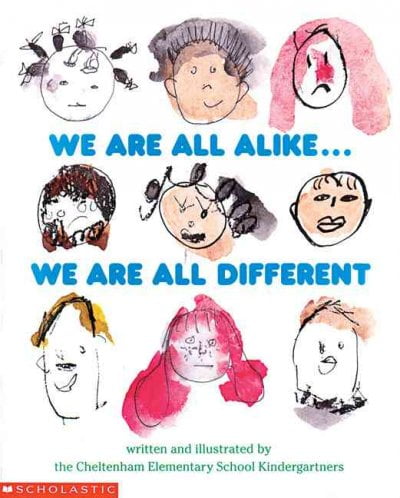Respects Rights, Diversity, Feelings, and Property of Others
What does “Respects Rights, Diversity, Feelings, and Property of Others” mean?
This skill is about learning that each person is an individual and deserves to be treated with kindness. It is important because it shows that children can treat others the way they want to be treated. This skill includes being respectful of:
- the rights of others. For example, taking turns and sharing.
- the unique ways people look, speak, and think. For example, learning about the food from another culture.
- the feelings of others. For example, being nice to a friend when they are upset.
- the property of others. For example, not taking things that belong to others without asking.
What does this skill look like?

At Home
While playing outside with friends, Max decides to go back to his house and get his football. He runs inside where his brother is working hard to stack blocks in the middle of the room. Max sees his brother working hard and slows down so he won’t accidentally knock the blocks over and upset his brother.

In The Classroom
Sonya’s friend brings a toy in for show and tell. Sonya really wants to play with the toy, but her friend says that it is very special, and she doesn’t want anyone to touch it. Sonya knows the toy doesn’t belong to her and that her friend will get upset if she touches it without her permission, so she plays with a different toy instead.
 Children can see the value of “Respects Rights, Diversity, Feelings, and Property of Others” in the book:
Children can see the value of “Respects Rights, Diversity, Feelings, and Property of Others” in the book:
We Are All Alike…We Are All Different
For more information about this book and other books that highlight this skill, visit our READING LIST page.
TIPS FOR FAMILIES
How can I explain this skill to my child?
Remind your child that we all have similarities and differences. Point out some obvious similarities and differences between you and your child. For example, you both love to play outside or you have long hair and your child has short hair. Remind your child that our similarities connect us, and our differences are what make us special.
At home, we are all on the same team, but we each have different roles to play and have something special to contribute. For example, a football team has players who throw the ball, players who catch the ball, and players who kick the ball. Even though they all have different roles, the players are on the same team and need to respect each other to help the team win. Just like a team, everyone at home has a different but important role. When we respect each other and work together, our team can be successful!
What are some things I can do to help my child learn this skill?

Talk to your child about what feelings look and sound like. Being able to identify feelings helps your child recognize their own feelings and the feelings of others. Recognizing the feelings of others is the first step to building respect for different points of view.
| Ways to help your child learn about emotions: | What do I say? |
|---|---|
| Use pictures, puppets, or yourself to act out feelings. Ask your child to name the feeling. | You make a sad face and crying sounds. “How do you think I feel right now?” |
| Ask your child to act out an emotion and give them a mirror so they can see how their face looks to others. Ask your child to make an “I statement” about their feeling. | “Now you try! Show me one of your feelings.” “Tell me what you’re feeling by saying ‘I feel ______’. ” |
| When reading a book or watching TV, ask your child to identify how characters feel and why they think the character feels that way. | “How do you think Clifford felt when his friend went home?” “How do you know Clifford is sad?” |

Step inside my shoes. Before they develop respect for others, your child must learn how to take the perspective of someone else. Encourage your child to step into another person’s shoes by asking them questions about the point of view of a character in a book, movie, or TV show. Ask your child questions like these:
| Talk to your child about what characters… | What do I say? | |
|---|---|---|
SEE |  | “What do you think that person sees?” |
THINK |  | “What do think that person is thinking about?” |
CARE ABOUT |  | “What do you think that person cares about?” |
HAVE QUESTIONS ABOUT |  | “What questions do you think that person has?” |

Getting to know you. Your child can learn about the perspectives of others by asking people questions about what they like and dislike. You can practice this with your child by asking questions about what they like and dislike and sharing your opinion. For example, when you are at the grocery store with your child, try this activity:
| What do I do? | What do I say? |
|---|---|
| Try to find one [fruit, vegetable, snack] that you both like by asking your child questions and having them ask you questions back. | “Do you like grapes? Oh, you don’t. Well, I love grapes! Let’s try to find a fruit we both like. Now you ask me if I like a different fruit.” |
| Try to find one [fruit, vegetable, snack] that you both dislike by asking your child questions and having them ask you questions back. | “Let’s find a vegetable that we both dislike. Do you like onions? You don’t. Me neither! We both dislike onions. Now it’s your turn to ask me about a different vegetable.” |
How can I encourage my child when I see them trying to learn this skill?
Acknowledge your child for their efforts! For example, tell your child, “Sonya, you are doing a great job being kind to your friend and sharing that book” or “Max, you are working hard to be quiet so your brother can finish his homework.” Click here for more ideas on how to encourage your child.
To download a printable PDF of the tips for this skill, click here.
TIPS FOR TEACHERS
How can I explain this skill to children?
Let children know that we all have similarities and differences. Point out some simple similarities and differences between people (for example, some people love the color blue while others love the color red). Remind children that our similarities connect us, and our differences are what make us special.
In the classroom, we are all on the same team, but we each have different roles to play and have something special to contribute. For instance, a football team has players who throw the ball, players who catch the ball, and players who kick the ball. Even though they all have different roles, the players are on the same team and need to respect each other to help the team win. Just like a team, everyone in the classroom is different but important. When we respect each other and work together, our team can be successful!
What are some examples of best practices from educational experts and fellow teachers?

Word of the week. It is important for children to develop a vocabulary for talking about feelings. This helps support children’s ability to recognize emotions and helps them build compassion for others. Create a feelings chart and hang it up in the classroom. Choose a word each week to focus on from the feelings chart and:
- Encourage children to look for these feelings in their everyday life.
- Have them draw pictures of the feeling.
- Pick stories that highlight the feeling to read together.
- Share the word of the week with families, so they can use it at home too.
Our Feeling Words
HAPPY | |
SCARED | |
ANGRY | |
SURPRISED | |
EXCITED | |
CALM |

Step inside my shoes. To develop respect for others, children must learn how to take the perspective of other people. Encourage children to step into another person’s shoes by asking them questions about what others see, how they feel, and what they think. Use this exercise with literacy activities or activities that involve pictures or storytelling. Guide children through the questions below during these activities. DOWNLOAD THIS CHART and post it in the classroom to remind children of what the questions are.

SEE |  | What can this person see? |
FEEL |  | What might this person feel? Show me with your face how this person feels. |
THINK |  | What do you think this person thinks, knows, or believes? |
CARE |  | What does this person care about? |
WONDER |  | What might this person have questions about? |

Getting to know you interviews. Encourage children to learn about their similarities and differences by having them interview each other. Place children in pairs and have them take turns asking each other about their likes and dislikes. After the interviews, have each pair share a common like and a common dislike with the class. Pairs can ask each other questions like:
- What kind of animals do you like the most/least?
- What is your favorite/least favorite number?
- What do you like/dislike about school?
- What is your favorite/least favorite food?
- What color do you like/dislike most?

Kindness chart. Show children that kindness matters by creating a kindness chart to record when someone does something kind for someone else. For example, you can create a kindness caterpillar and hang it in the classroom. When a child does something kind, you can write what they did on a section of the caterpillar’s body. As the year goes on, the caterpillar will grow and show all of the kind things the children have done for each other!

How can I encourage children when I see them trying to learn this skill?
Acknowledge children for their efforts! For example, say, “Sonya, you are doing a great job being kind to your friend and sharing that book” or “Max, you are working hard to be quiet so others can finish their work.” Click here for more ideas on how to encourage children.
To download a printable PDF of the tips for this skill, click here.

Start your morning with Conquering Kindergarten!
Hey teachers, want to incorporate Conquering Kindergarten into your community meeting each morning? Go to the district’s Community Meeting App to find ready-to-use slides highlighting this skill. Filter content in the app by Conquering Kindergarten or by a specific skill to get access to interactive and engaging slides tailored to the community meeting format.
To learn more about the tips and where they came from, please visit our references page.
